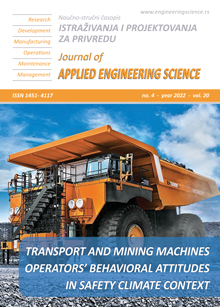EFFECT OF CLIMATE CHANGE ON ANNUAL WATER ALLOCATION PLAN
Abstract
The most felt impact due to climate change in Indonesia is the climate anomaly. This condition will affect the planning of water allocation. The purpose of this study was to determine the impact of climate change on the annual water allocation plan. This research was conducted in the Bangga watershed, Indonesia. The methods used include climate change detection, irrigation water needs, domestic and non-domestic water needs, water availability, water balance, and an annual water allocation plan. The data used is daily rainfall data for 29 years (1993-2021) from Bangga Atas and Bangga Bawah stations and climate data from Bora station for the same period. The results of this study are: there has been a change in climate in the Bangga watershed and there has been an increase in rainfall in the last 10 years so the availability of water has also increased. Climate change has a very big influence on the availability of rivers, especially in the dry year, causing a water deficit. This condition applies to the period 1995-2021. In normal year conditions and wet year conditions, there is a change in the status of the water balance from deficit to surplus for the last 10 years. The annual water allocation plan based on the period 2012-2021 is proposed as an annual water allocation plan for the next five years and can be reviewed after three years. Meanwhile, the strategy to reduce the water shortage deficit is to make a priority scale for all water needs.
References
K. M. Arsyad. (2017). Annual Water Allocation Plan Module, Bandung: Minister for Public Works and Human Settlements.
Frety Anggreani, Agus Susatya and Syafrin Tiaif. (2019). The Level of Vulnerability to Climate Change in the Villages Around the Kerinci Seblat National Park (TNKS) in Pinang Belayer District, Lebong Regency, Bengkulu Province. Naturalis Jurnal Penelitian Pengelolaan Sumber Daya Alam dan Lingkungan, vol. 7, 109-119.
BPS, Badan Pusat Statistik. (2021). Dolo District in Numbers. Central Bureau of Statistics, Sigi.
Moyan Li, Jingyun Guan and Jianghua Zheng. (2022). Climate Drivers Contribute in Vegetation Greening Stalls of Arid Xinjiang, China: An Atmospheric Water Drying Effect. Water, vol. 14, no. 13, 1-22.
Yinge Liu, Yuxia Xu, Yaqian Zhao, and Yan Long. (2022). Using SWAT Model to Assess the Impacts of Land Use and Climate Changes on Flood in the Upper Weihe River, China. Water, vol. 14, no. -, 1-23. https://doi.org/10.3390/w14132098
Mohammad Zare, Shahid Azam, and David Sauchyn. (2022). Impact of Climate Change on Soil Water Content in Southern Saskatchewan, Canada. Water, vol. 14, no. -, 1-17. https://doi.org/10.3390/w14121920>
I W. Sutapa and M. G. Ishak. (2016). Application of non-parametric test to detect trend rainfall in Palu Watershed, Central Sulawesi, Indonesia. Int. J. Hydrology Science and Technology, vol. 6, no. 3, 238-253.
I W. Sutapa. (2015c). Long-Term Trend Climatology in Sigi, Central Sulawesi province, in National Seminar on Civil Engineering Narotama of University,, Surabaya.
I W. Sutapa. (2017). Effect of Climate Change on Recharging Groundwater in Bangga Watershed, Central Sulawesi of Indonesia. Environ. Eng.Res.J., vol. 22, no. 1, 87-94.
I W. Sutapa, Saiful Darman, Djayani Nurdin and Faturrahman. (2021). Impact of climate change on the water sector in Gumbasa. Int. J. Hydrology Science and Technology, vol. 11, no. 2, 211-231.
Asta. (2018). Clean Water Needs Analysis and PDAM Network Distribution. Borneo Engineering: Jurnal Teknik Sipil, vol. 2, no. 1, 61-68.
I W. Sutapa. (2015a). Study Water Availability of Malino River to Meet the Need of Water Requirement in District Ongka Malino, Central Sulawesi of Indonesia. International Journal Of Engineering and Technology, vol. 7, no. 3, 1069-1075.
Lily M. L. and Whima R. P. (2016). Analysis of the Reliability of Reservoir Storage in Pocok Pocok Embung Bangkalan. Journal Teknik Sipil, vol. 23, no. 2, 127-134.
Meylis Safriani, Alfiansyah Yulianur and Azmeri. (2016). Analysis of the Effect of Palm Oil Land Interception on Water Availability in Nagan Raya Regency (Case Study in Krueng Isep Sub-watershed). Journal Teknik Sipil, vol. 23, no. 2, 135-144.
I W. Sutapa. (2015b). Modeling Discharge of Bangga Watershed under Climate Change. Applied Mechanics and Materials Journal, vol. 776, 133-138.
A. S. Ansari, I. W. Sutapa and M. G. Ishak. (2017). Model Hydrology MockWyn-UB to Analyse Water Availability in Gumbasa Watershed Central Sulawesi Province. Int. Journal of Engineering Research and Application, vol. 7, no. 1, 94-101.
I W. Sutapa, Saparuddin, Yassir Arafat, Sance Lipu, Nina B. Rustiati and I Putu Hendra Adi Pratama. (2022). The Performance of Thirty-Eight Evapotraspiation Methods against the Penman Montieth Method. Journal of Engg. Research, vol. accepted, 1-16.
I W. Sutapa, Yassir Arafat, I Gede Tunas and Fitrianti. (2021). Impact of Climate Change on the Water Sector in the Singkoyo Watershed, Central Sulawesi, Indonesia. ARPN Journal of Engineering and Applied Sciences, vol. 16, no. 4, 399-417.
Xinyi Song, Fan Lu, Weihua Xiao and Kui Zhu. (2018). Performance of 12 reference evapotranspiration estimation methods compared with the Penman-Monteith method and the potential influences in northeast China. Journal of Engg. Research, vol. 26, no. -, 83-96.

